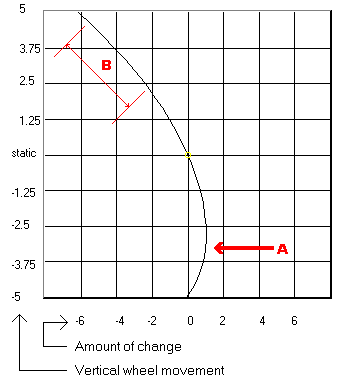
Reading and analyzing your suspension's camber curves is a very important step in improving your race car's handling.
The term Camber is used to describe the tilting of a wheel/tire. If the top of the tire is leaning outward from the car, then this is called "positive" camber. Conversely, if the top of the tire is leaning in toward the car, this is called "negative" camber.
Camber is measured in degrees of tilt. 1.5 degrees of positive camber means the top of the wheel is leaning outward 1.5 degrees. Likewise, 3 degrees of negative camber means top of the wheel is leaning inward 3 degrees.
While your car's camber is adjustable in the garage, it also changes on the race track. This is why it is important to examine the camber curve (see sample below).

Parts of the Camber Graph
The numbers on the left side of the graph represent the up and down travel of a wheel or suspension. The line in the middle labeled "static" is the wheel (or suspension) position when the race car is at rest or standing still.
The negative (-) numbers represent the condition where the wheel moves downward from the frame. This could happen when the tire drops into a pothole, or when the inside of the chassis lifts as during body roll in a corner.
The positive numbers above the static line are where the wheel has moved up in relation to the chassis. This can be a case where the tire is going over a bump or when the outside of the frame drops as during body roll in a turn.
The numbers on the bottom of the graph are used to identify the wheel's camber change. The curving line on the graph is the camber change for each position of the wheel's vertical movement.
Using the static line and the "0" camber line, the graph can be divided into 4 quadrants (top left, top right, bottom left, bottom right). Typically, it is desirable to have a camber curve that is in the top left and bottom right quadrants.
Stock car suspensions from the 60s and 70s often had camber curves that ran from the top right through the bottom left quadrant. This is almost always undesirable for high performance handling.
Desired Shape of Line
The next step in analyzing and improving your camber curve after getting the line in the proper quadrants (or if you were lucky to have it in the proper quadrants to start), is to achieve a specific line shape on the camber graph.
Depending on the type of track and car you will have different requirements. On a flat track with small or no sway bars, generally your camber curve should be less of a curve and more of a straight line. Ideally the line would slope uniformly from the top left to the bottom right of the graph. On big bar soft spring setups the left and right sides may need different camber lines and often a very steep sloping line works better than a flatter sloped line.
Good and Bad Parts of Line
Many stock car suspensions will have a camber curve that looks like the one in the example. The hook part of the line where the arrow "A" is pointed is undesirable if you have a lot of rebound (or extention) of the inside suspension when cornering.
If your car squeals the inside front tire in a corner, there is a good chance you have a camber curve with a hook. Short track race cars that have a camber curve (like the example) often require larger amounts of positive camber in the left front tire in order to keep the car from pushing in the middle of the turns.
Again, the region of the line marked B is typically a desirable shape. Notice that here the line it is flatter and less curved than at the opposite end of the line.
When analyzing your suspension, if you are limited to modifications due to rules, your handling could be improved by lowering or raising your frame height. One way of thinking about this is that lowering or raising the ride height will move the camber curve to a different static spot on the graph. This can bring the better portion of the curve to the operating range in the corners.
Software Benefits
Just the ability to generate a camber curve can be an advantage over your competition. Having the ability to quickly try suspension changes and see how they impact your camber curves is a sizable advantage.
Now, imagine if you had a computer program that examined your suspension curves and made suggestions on what items could be changed/moved to improve the camber curve. Not only could you apply your own knowledge of camber curves, but the software would be helping to solve problems, too!
While this sounds futuristic, this is exactly what the Front Suspension Geometry Pro software does today. You can do more suspension development in one evening than other people do in a whole career of racing. Don't miss this huge advantage!